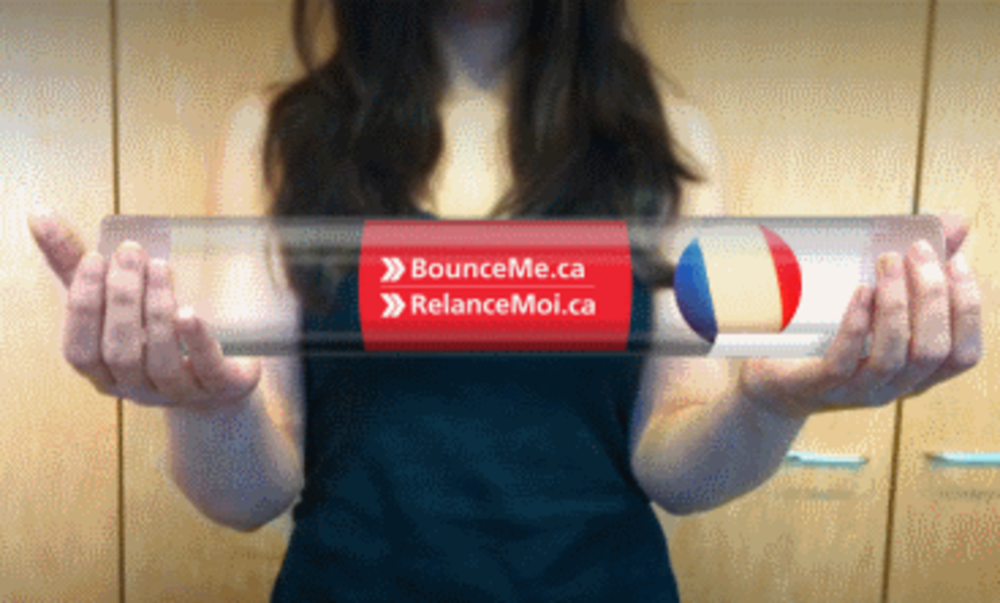The Back Story: Direct mail isn’t always just a letter in a white envelope—sometimes it’s a mysterious rubber bouncy ball that arrives on your doorstep in an unbranded clear plastic tube with simple and tantalizing instructions: Tell a story.
That was the idea Canada Post cooked up for its Bounce Me campaign, an effort launched earlier this year to edify agencies and client-side marketers about the value of direct mail in the marketing mix.
“A lot of them haven’t grown up using direct mail and now they’re focused on social and online,” says Jennifer Campbell, general manager of direct marketing strategy at Canada Post. “We have a great opportunity and undertaking to educate them on the fundamentals of direct mail.”
Campbell and her team did a series of focus groups last summer with agency folks across the board—copy editors, designers, creatives, account people—to understand how they perceive direct mail as a channel. Most said that direct mail usually isn’t top-of-mind and that clients aren’t always asking for it. They were, however, very open to learning more about how mail might be able to give them a competitive edge—and that edge comes when direct mail is used as part of a smart multichannel strategy.
“Direct mail with email, for example, will drive people online; or you can integrate direct mail with social—the challenge and the great opportunity is how to incorporate them together in a very cohesive and strategic way; and when you do that, you get great results,” Campbell says. “All direct mail is one-to-one.”
The Target: With the Bounce Me campaign, Canada Post was well aware of its audience: top Canadian agencies with the power to bring direct mail back into the fold.
“At Canada Post we’ve done some ad hoc stuff with agencies in the past,” says Campbell, who spent a portion of her career at an agency. “But I’ve always felt strongly that we were missing out on a very important group of influencers in the direct marketing food chain.”
The Creative: In the first phase of the campaign, Canada Post sent 1,053 marketing agency reps a special direct mail piece created by its agency of record, McMillan: a rubber ball in a plastic tube. The tube had no branding other than a link directing recipients to bounceme.ca. The goal, Campbell says, was to be attention-grabbing without giving too much away.
“There’s intrigue associated with getting something like that—it’s a simple playful thing you can come back to again and again,” she says. “It’s the power of something physical that drives you online and encourages you to share.”
The Strategy: Once on site, visitors were presented with this copy—“You have a ball. Every ball has a story”—and the following challenge: Use the ball to tell a compelling story, upload a video, and share. The prize for the most shared videos was a $1,000 to the wining agencies’ favorite charity.
Canada Post followed up with a reminder message—650 people received a direct mail piece, while 363 received an email—which drove an increase in voting and traffic.
“Our ultimate goal was getting attention from agencies and making them look,” Campbell says. “And you know what? We made them look, and that helps us start the conversation.”
Campbell says Bounce Me has also been helpful to the Canada Post sales team, part of which, as of August 2012, has been focused solely on reaching out to agencies. “This campaign is a door opener, so that when someone from Canada Post comes calling at an agency, they can refer to the ball and get the conversation rolling,” she says.
The Results: Within two days of mailing the ball in a plastic tube, 877 of recipients—83%—visited bounceme.ca. The follow-up email triggered a massive second wave of responses that in turn led to a 300% uptick in voting. Overall, the Bounce Me campaign brought in 3,198 hits, with visitors spending an average of three minutes and 50 seconds per visit. The 22 stories created and posted to bounceme.ca were shared more than 220 times.
The Takeaway: Direct mail isn’t just about cutting through the digital clutter—it’s about providing a more robust experience overall, Campbell notes.
“There’s so much neurological research that shows how the brain fires up when people have something physical in their hands versus when they see that same message on a screen,” she says. “But direct mail is also the perfect opportunity to drive to online.”
Part of the beauty of direct mail is also how trackable it is: “It’s easy to show ROI and it’s really helpful when you need proof and you’re asking for more marketing dollars,” she says.
And regarding open rates, the numbers don’t lie: About 80% of all physical mail is opened, while the same can be said for only about 20% of emails.
“It’s the only medium to get you to…every household and every business,” says Campbell. “Nothing else does that.”








